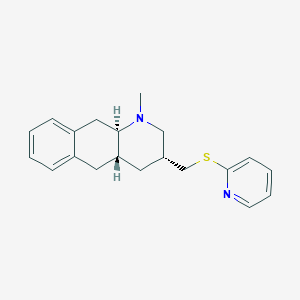| Drug General Information |
| Drug ID |
D0LE7P
|
| Former ID |
DIB014198
|
| Drug Name |
SDZ-GLC-756
|
| Drug Type |
Small molecular drug
|
| Indication |
Glaucoma [ICD9: 365; ICD10:H40-H42]
|
Discontinued in Phase 1 |
[1]
|
|---|
| Company |
Novartis AG
|
| Structure |

|
Download
2D MOL
3D MOL
|
| Formula |
C20H24N2OS
|
| Canonical SMILES |
N1([C@H]2[C@@H](Cc3c(C2)cccc3O)C[C@H](C1)CSc1ncccc1)C
|
| CAS Number |
CAS 149328-94-9
|
| PubChem Compound ID |
|
| Target and Pathway |
| Target(s) |
Dopamine D1 receptor |
Target Info |
Modulator |
[2]
|
|---|
| D(2) dopamine receptor |
Target Info |
Modulator |
[2]
|
|
KEGG Pathway
|
Calcium signaling pathway
|
|
cAMP signaling pathway
|
|
Neuroactive ligand-receptor interaction
|
|
Gap junction
|
|
Dopaminergic synapse
|
|
Parkinson's disease
|
|
Cocaine addiction
|
|
Amphetamine addiction
|
|
Morphine addiction
|
|
Alcoholismhsa04015:Rap1 signaling pathway
|
|
Alcoholism
|
|
PANTHER Pathway
|
Dopamine receptor mediated signaling pathwayP00026:Heterotrimeric G-protein signaling pathway-Gi alpha and Gs alpha mediated pathway
|
|
Heterotrimeric G-protein signaling pathway-Gq alpha and Go alpha mediated pathway
|
|
Dopamine receptor mediated signaling pathway
|
|
Nicotine pharmacodynamics pathway
|
|
PathWhiz Pathway
|
Dopamine Activation of Neurological Reward System
|
|
Reactome
|
Dopamine receptors
|
|
G alpha (s) signalling eventsR-HSA-390651:Dopamine receptors
|
|
G alpha (i) signalling events
|
|
WikiPathways
|
Hypothetical Network for Drug Addiction
|
|
Monoamine GPCRs
|
|
GPCRs, Class A Rhodopsin-like
|
|
Genes and (Common) Pathways Underlying Drug Addiction
|
|
GPCR ligand binding
|
|
GPCR downstream signalingWP666:Hypothetical Network for Drug Addiction
|
|
GPCR downstream signaling
|
|
Nicotine Activity on Dopaminergic Neurons
|
| References |
| REF 1 | Trusted, scientifically sound profiles of drug programs, clinical trials, safety reports, and company deals, written by scientists. Springer. 2015. Adis Insight (drug id 800008736) |
|---|
| REF 2 | SDZ GLC 756, a novel octahydrobenzo[g]quinoline derivative exerts opposing effects on dopamine D1 and D2 receptors. J Neural Transm. 1996;103(1-2):17-30. |
|---|